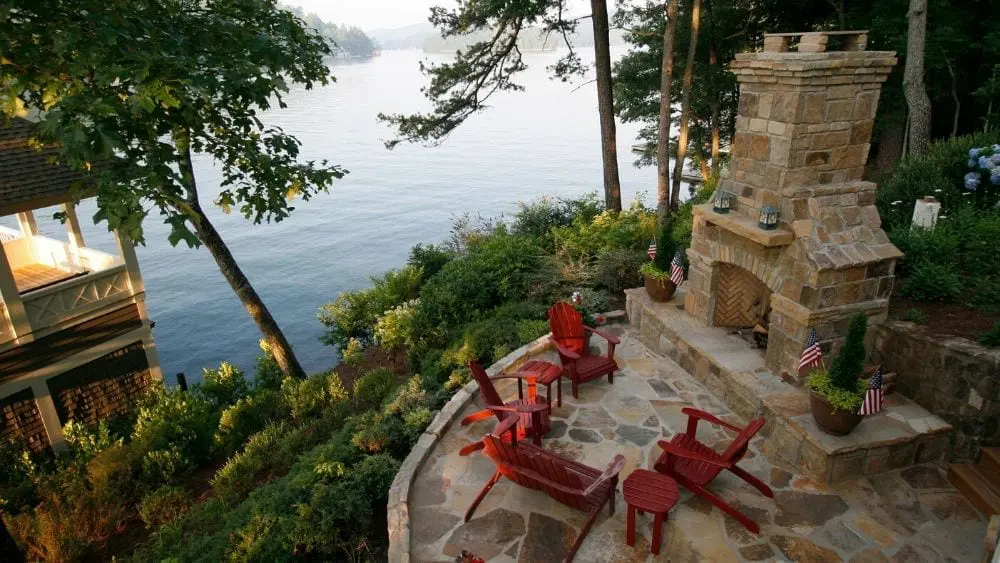
Itching to spend some time in your garden or entertaining on your porch this fall and winter? No problem — here’s how.
Having put so much effort into creating the outdoor living space of your dreams, the colder times of year can be a let-down, because you’re anticipating months of chilly weather that hampers your ability to spend family time or entertain guests in the garden.
A 2016 study by the American Home Furnishings Alliance actually found that more than 70 percent of U.S. households include outdoor living spaces, and 71 percent of those households would like to enhance their spaces to make them more relaxing.
To do so, you can extend your outdoor living season by incorporating a heat element like a fire pit, fireplace or electric heat lamp and soon you’ll see the arrival of fall and winter as an opportunity to experience your backyard a whole new way.
Palm Beach, Fla., landscape architect Phil Maddux offers this piece of advice for those who would avoid the cold: “My first suggestion is to move to South Florida or the Caribbean.” Humor aside, Maddux has a few other tips for how your landscape design can increase warmth.
People don’t often think of their outdoor kitchens as a source of warmth, but as Maddux reminds us, “the heat generated from the BBQ keeps the immediate area warm.”
He also encourages smart planting techniques that screen breezes. “Place and trim trees to block the winter winds,” he says. “At our own home, we use landscape lighting for effect and it also raises the temperatures. It also helps on cold nights to keep plants warm.”
Take a Dip
Heather Lenkin, a landscape designer in Pasadena, Calif., encourages her clients to spend as much time in the garden as possible.
“As the seasons and the weather turn, the best way to invite people out is to have a warm spot to sit and enjoy themselves,” says Lenkin. “Fire elements are intriguing, fun to watch and provide the warmth you need when the sun goes down. We’re lucky that there are so many options from which to choose — anything from a portable (heater or fire pit) to a custom-designed element is a perfect invitation to linger. Fire creates beautiful light and encourages people to group closely together and visit.”
Lenkin’s firm recently completed a backyard that has spaces for entertaining, reading, gardening, loafing, soaking and toasting. Despite the space being small, Lenkin was able to efficiently incorporate a whirlpool bath and seating that extends from the bath around a simple, but modern, custom fire element.
Spas are a fabulous way to bring heat to a garden. With or without a nearby heating element, their warmth is a great lure, even in the winter.
Gimme Shelter
In the Seattle, Wash., area where author and outdoor living expert Debra Prinzing lives, more people are gravitating outdoors year-round, regardless of the temperature.
“Having a source of warmth outdoors is one of the most effective ways to enjoy your landscape when temperatures move beyond sweater weather. Two key design features make this possible,” says Prinzing. “First, overhead cover; second, a heat source.
“I have a covered back porch with a two-sided gas fireplace (it faces the library inside and the porch outside),” she says. “Nothing is more cozy than sitting outdoors, next to the fire, under cover from the porch roof while I sip a mug of tea and watch the rain fall.”
Fan the Flame
David Marciniak is a garden designer in McLean, Va., known for designing fireplaces and fire pits for his clients. When he’s advising clients on which to choose for their backyard, he says “the biggest design consideration with fire features comes down to how the client will use them.”
Each one has a unique appeal, Marciniak says. “Fire pits are less formal looking and very communal in function. Think s’mores with the kids, laughing and chatting with friends with a few beers and a guitar. A fireplace is much more formal but also dictates a much more formal seating grouping,” he says.
Another option is an electric heating unit, which can be moved to wherever you are. Hosting a dinner? Place the unit near the table. Sitting on a deck chair and reading a book? Roll the unit closer.
“During the cool evening hours, a viable option would be a cost-effective outdoor heating system,” explains Stephen Senzatimore, who designs and builds TimberTech composite decks and hardscapes in Farmingdale, N.Y. “There are several that average a couple hundred dollars, from high-efficiency electric (units) to liquid propane and natural gas options.”
Play It Safe
For outdoor entertaining in cooler weather after the sun goes down, there is nothing like the crackling warmth of a fire pit to keep things cozy. Spending much of his time in gardens, Senzatimore has seen the advantages of incorporating fire features for warmth — and he’s also seen the hazards.
Having a source of warmth outdoors is one of the most effective ways to enjoy your landscape when temperatures move beyond sweater-weather. — Outdoor Living Expert Debra PrinzingHe offers cautionary advice that applies to installation and use of fire pits. “Situate your fire pit on a non-combustible, solid, steady surface such as a stone or brick patio. Never put it directly on or near a wood deck. If you do have a wood deck, then keep it on a fire pit pad, stone slabs or bricks over the wood,” he says.
Every year, an average of 6,500 grill fires result in nearly $27 million in property losses, according to the U.S. Fire Administration. “There are several types of fire pits on the market today and they all have one thing in common — the need for safety,” Senzatimore says. “It’s best to exercise the same precautions as you would with an open fire.”
No matter what type of fire pit you purchase, don’t place it under a covered porch or under low-hanging tree branches. Never use flammable fluids like gas, kerosene or lighter fluid to light your fire unless you feel like inviting the local fire department to your party. Senzatimore offered tips for a safe and happy experience with a fire pit:
- Make like a Boy Scout and start fires with crumpled newspaper or a commercial fire-starter stick and then add wood in moderation. Don’t use woods that have been treated with creosote or CCA, as they can be toxic when burned.
- Starting slowly helps you see the direction of the wind and the effect on the flame.
- Never leave your fire pit unattended, even if you want to make a quick dash to the woodpile for more wood. Keep the amount of wood you plan on burning on-hand so you don’t have to walk away.
- Don’t allow children near the fire pit unless there is adult supervision. Pets should also be closely monitored.
- Always have a container of water and a garden hose close by before starting the fire in case it gets out of control. You’ll also need the water later when it’s time to put your fire out.
- A fire pit is a place your guests can huddle for conversation and warmth. Keep your fires small. There’s no need for a blazing bonfire.
- One way to extinguish a fire at the end of the evening is to spread the ashes over a large surface area and let them cool down for a little bit. Then take your container of water and gently pour it over the ashes. There are also fire-dampening powders that completely smother the fire.
Consider the Source
It’s tempting to get creative with what you use as a fire pit, but Brent Freitas of Eye of the Day in Santa Barbara, Calif., suggests carefully considering the materials a pit is made of before using it to contain fire.
“Heat ultimately fatigues everything and anything, so the quality of the material the vessel is made from can make a big difference,” he says. “Weak clay makes for an easily cracked fire pit. If you use concrete, make sure it is strong and high quality. There are heat resistant paints you can apply to the inside of the bowl to help reflect heat away from the sides of the pit.”
While you may be tempted to use a decorative pot or container from the store, it’s important to make sure the container will stand up to the heat — in most cases, they won’t, so it’s best to choose a pit or container that is specifically made for that purpose.
The cold weather doesn’t have to mean an end to your outdoor entertaining. By using items such as portable heaters or fire pits, you can extend the outdoor living season into both fall and winter.

Sarah Kinbar is a writer and editor with a passion for design and images. She was the editor of Garden Design magazine, curating coverage of residential gardens around the globe. As the editor of American Photo, Kinbar worked with photographers of every genre to create a magazine that told the story of the photographer’s journey.
She has been writing about architecture, landscape design and new-home construction for NewHomeSource since 2012. During that time, she founded Kinship Design Marketing, a boutique agency that provides content for website redesigns, blogs, inbound marketing campaigns and eNewsletters.
 15 Questions to Ask When Selecting a Home Builder
15 Questions to Ask When Selecting a Home Builder